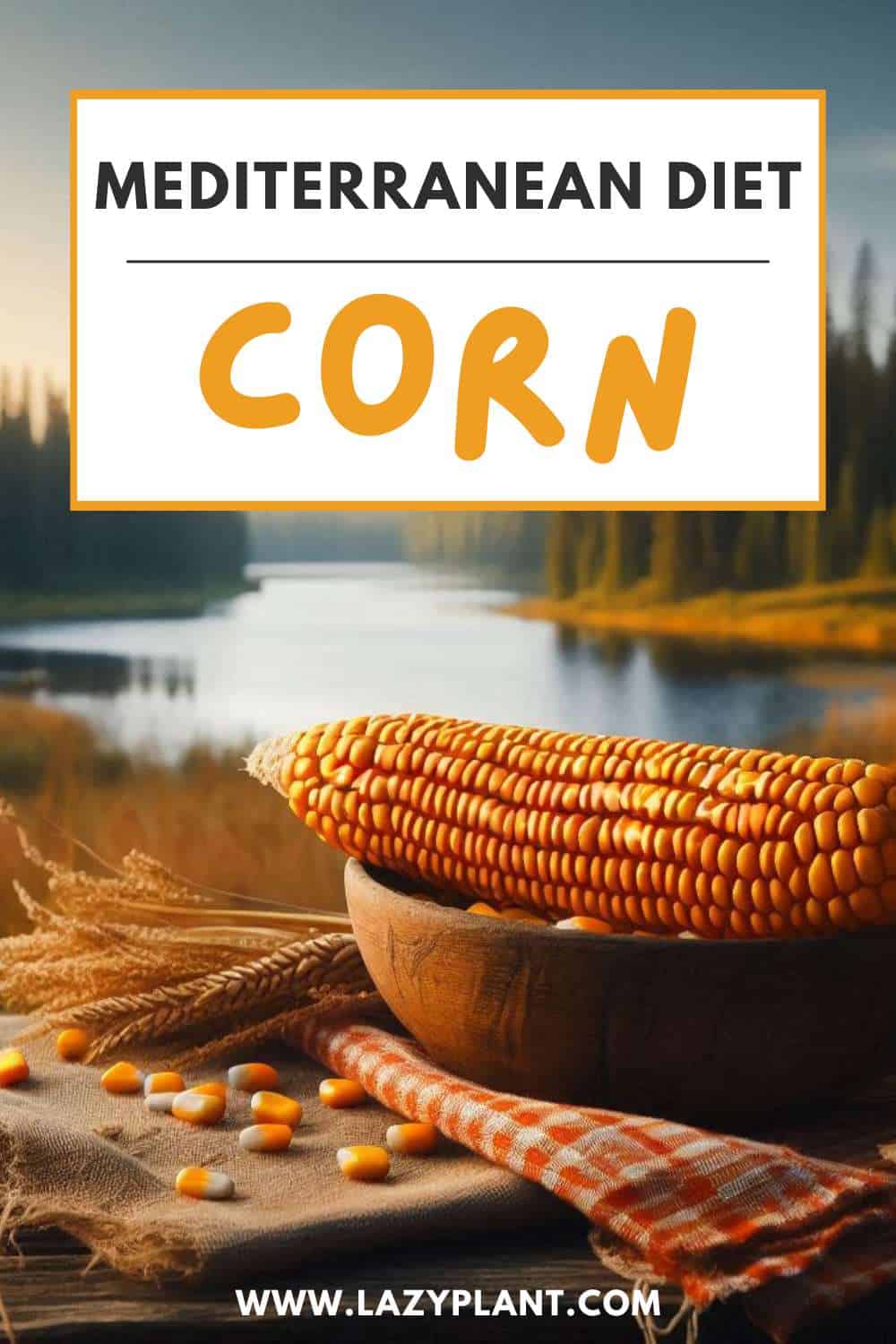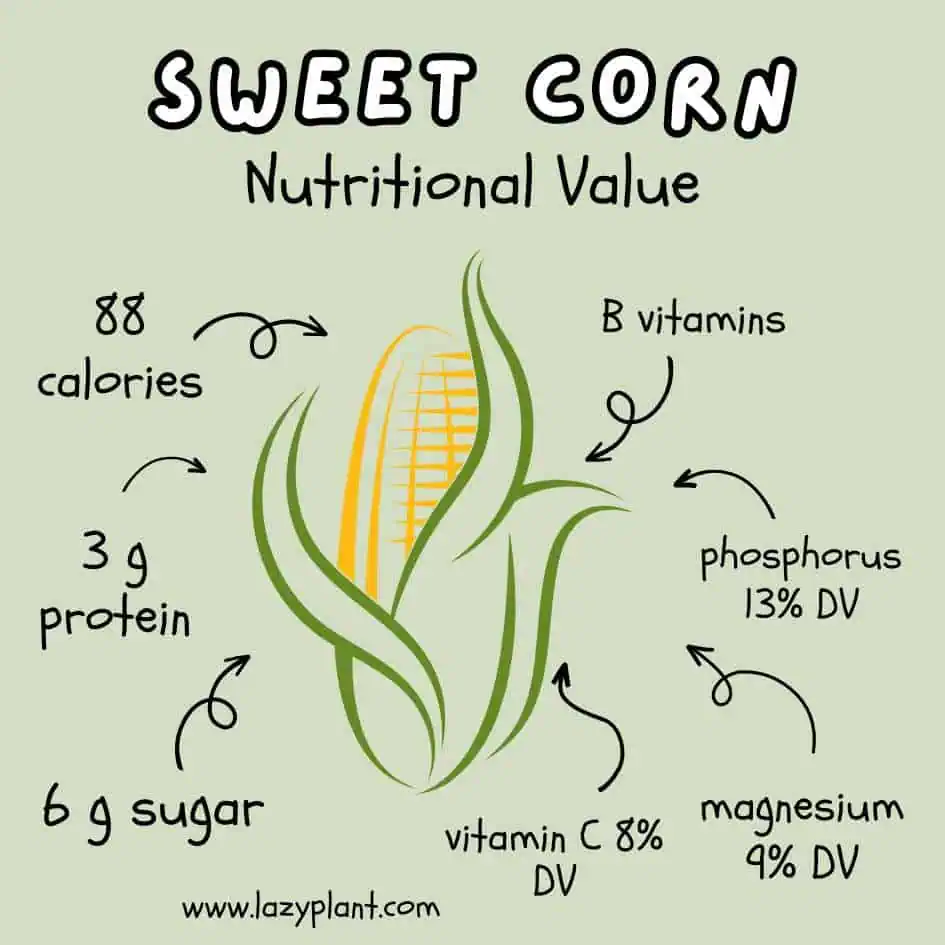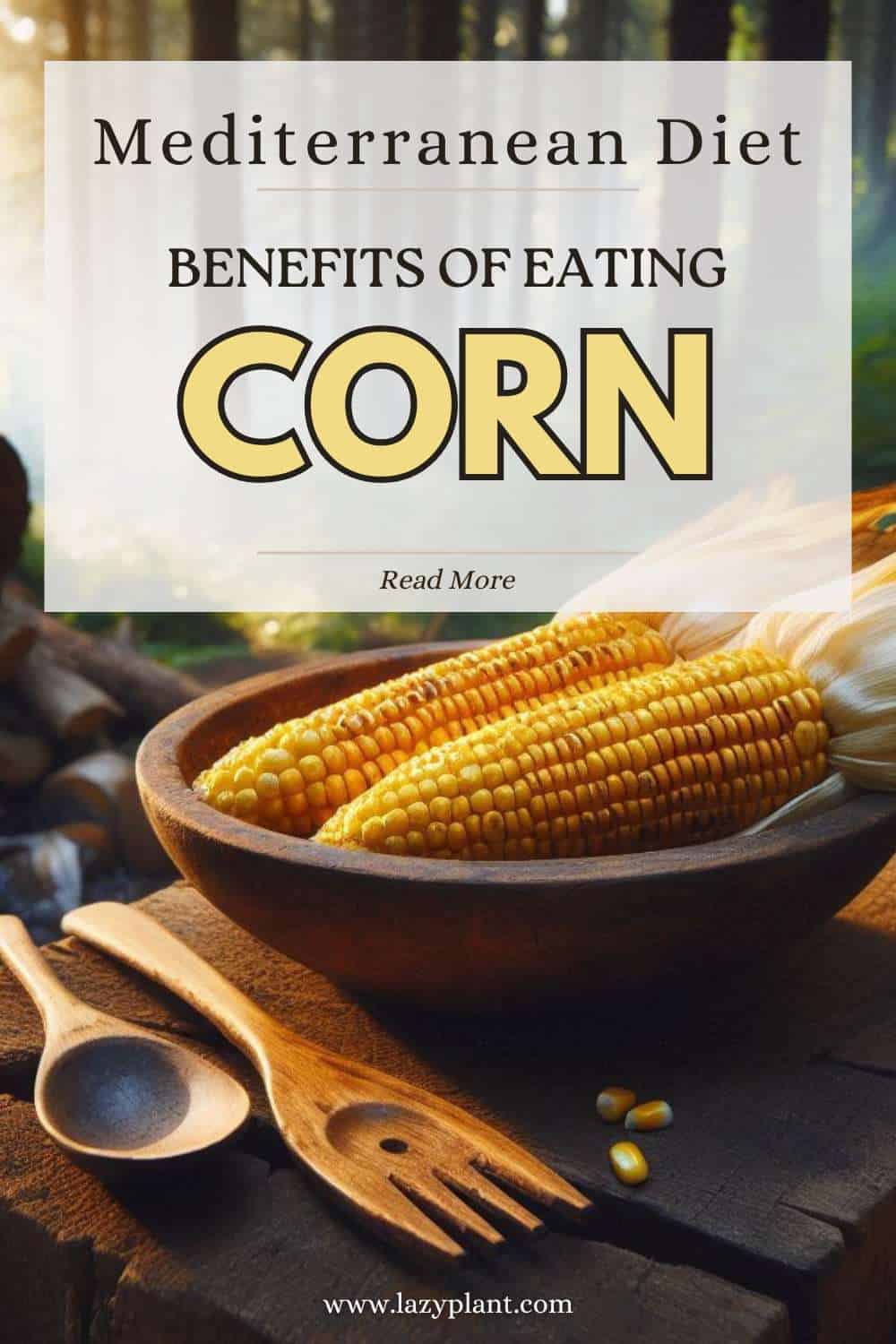Sweet corn is not traditionally considered a part of the famous Mediterranean diet, which focuses on fresh, locally sourced ingredients that are minimally processed and rich in nutrients. However sweet corn is enjoyed in various modern Mediterranean dishes.
Table of Contents
- Benefits of the Mediterranean Diet for Health & Weight Loss
- How Old is the Mediterranean Diet?
- Health Benefits of Sweet Corn
- Sweet Corn Origin
- Can Corn be Part of the Mediterranean Diet?
- How do people in the Mediterranean Area eat Corn?
- Corn Cultivars around the Mediterranean Sea
- Recipes with Sweet Corn in Mediterranean Cuisine
- Other Traditional Vegetables of the Mediterranean Diet

Benefits of the Mediterranean Diet for Health & Weight Loss
The Mediterranean diet, rich in fruits, vegetables, whole grains, legumes, nuts, and olive oil, is renowned for its numerous health benefits.
One of the primary advantages is its positive impact on cardiovascular health. Studies have shown that adhering to this diet can significantly reduce the risk of heart disease and stroke. The high intake of monounsaturated fats, primarily from olive oil, and omega-3 fatty acids from fish, helps lower bad cholesterol levels and increase good cholesterol.[1,2,3]
Additionally, the diet’s emphasis on plant-based foods, lean protein, and healthy fats contributes to better blood pressure regulation and improved overall heart function.
Moreover, the Mediterranean diet is associated with a lower risk of chronic diseases such as type 2 diabetes, certain cancers, and neurodegenerative disorders.
The antioxidants and anti-inflammatory properties of the diet’s components play a crucial role in combating oxidative stress and inflammation, which are underlying factors in many chronic conditions.
The diet’s emphasis on whole, minimally processed foods means that it is naturally lower in sugars and unhealthy fats, further promoting overall health and disease prevention.
Weight Loss
Unlike restrictive diets, it promotes a balanced intake of macronutrients, which helps maintain a healthy metabolism.
The high fiber content from fruits, vegetables, and whole grains keeps you feeling full longer, reducing the likelihood of overeating.
The diet also encourages the consumption of healthy fats, which are more satiating and help prevent hunger pangs.
This balanced approach to eating not only supports gradual and sustainable weight loss but also ensures that the body receives essential nutrients for optimal function.
The Mediterranean diet is not just a method for weight loss but a comprehensive lifestyle choice that promotes long-term health.
How Old is the Mediterranean Diet?
The Mediterranean diet, as we understand it today, is based on traditional eating patterns that have been followed by people living in countries around the Mediterranean Sea for centuries. While it’s difficult to pinpoint an exact age for the diet, its roots can be traced back to ancient civilizations such as the Greeks, Romans, and Egyptians.
These populations relied heavily on locally available foods, which included a variety of fruits, vegetables, legumes, nuts, whole grains, fish, and olive oil, supplemented occasionally with dairy, poultry, and red meat.
This way of eating was shaped by the geography, climate, and agricultural practices of the region, and it evolved over time with cultural exchanges and trade.
The modern concept of the Mediterranean diet began to take shape in the mid-20th century. The pioneering work of American physiologist Ancel Keys in the 1950s and 1960s brought significant attention to the health benefits of the Mediterranean way of eating. Keys’ “Seven Countries Study” examined the dietary patterns and health outcomes of people in various countries, including Greece and Italy, and found a strong correlation between the Mediterranean diet and lower rates of heart disease.[4,5]
Therefore, while the Mediterranean diet has ancient origins, its recognition and formalization as a specific dietary pattern with documented health benefits emerged more prominently in the last 70 years.
Health Benefits of Sweet Corn
Sweet corn, a popular summer vegetable, offers numerous health benefits due to its rich nutritional profile. It’s packed with essential vitamins and minerals. It contains B vitamins (such as thiamine and folate), which are crucial for energy production, brain function, and DNA synthesis.
Additionally, it provides vitamin C, an antioxidant that supports the immune system, skin health, and wound healing.
One of the most significant benefits of sweet corn is its high fiber content. Dietary fiber is essential for digestive health, helping to prevent constipation and promote regular bowel movements. Fiber also contributes to satiety, helping you feel fuller for longer, which can aid in weight management. Also, the fiber in sweet corn can help lower cholesterol levels, which is beneficial for heart health.
Due to its fiber content and low fat, sweet corn can be a supportive food for weight management. It helps keep you full and satisfied, reducing the likelihood of overeating and unhealthy snacking between meals. Moreover, sweet corn is a good source of complex carbohydrates that are a primary energy source for the body. These carbohydrates are digested slowly, providing a steady release of energy and preventing blood sugar spikes.

Sweet corn is versatile and can be incorporated into many dishes, from salads and soups to salsas and casseroles. Its natural sweetness and crunch make it an enjoyable addition to a balanced diet.
Sweet corn is rich in antioxidants like lutein and zeaxanthin, which are known to support eye health by reducing the risk of cataracts and age-related macular degeneration. These antioxidants also help protect the body’s cells from damage caused by free radicals, potentially lowering the risk of chronic diseases.
Moreover, it contains potassium, which helps regulate blood pressure by counteracting the adverse effects of sodium. Folate in sweet corn also supports cardiovascular health by reducing homocysteine levels in the blood.
For individuals with celiac disease or gluten sensitivity, sweet corn is an excellent gluten-free option. It can be used in various gluten-free recipes, providing a safe and nutritious alternative to wheat and other gluten-containing grains.
Sweet Corn Origin
The cultivation and consumption of sweet corn (Zea mays var. saccharata) have deep historical roots tracing back to ancient Mesoamerica.
Ancient Origins
Sweet corn, like all varieties of maize, originated in Mesoamerica, specifically in the region that includes modern-day Mexico and Central America.
The domestication of maize from its wild ancestor, teosinte, occurred around 9,000 years ago. Through selective breeding, indigenous peoples developed maize with larger cobs and more kernels, gradually evolving into the various forms of maize we recognize today, including sweet corn.[6,7]
Early Cultivation
The ancient civilizations of Mesoamerica, such as the Aztecs and the Maya, relied heavily on maize as a staple food. Maize was deeply integrated into their agriculture, diet, and culture. It provided essential nutrients and calories, supporting large populations and complex societies.
Spread to North America
Maize cultivation spread northward over the millennia, reaching the present-day United States and Canada. By the time European explorers arrived in the 15th and 16th centuries, maize was a vital crop for many Native American tribes. These tribes had developed various maize varieties suited to different climates and growing conditions.[8]
Introduction to Europe and Beyond
After Christopher Columbus’s voyages to the Americas, maize was introduced to Europe and other parts of the world. European settlers quickly adopted maize cultivation, appreciating its versatility and high yield.
Sweet corn, specifically, became more widely known and cultivated for its tender, sweet kernels, distinct from the starchy varieties commonly used for flour and animal feed.
Modern Cultivation & Consumption
In the 18th and 19th centuries, sweet corn began to be selectively bred for its sweet taste and tender texture. It became a popular vegetable crop in the United States and other temperate regions.
Advancements in agricultural practices and hybridization in the 20th century further enhanced sweet corn varieties, improving their sweetness, tenderness, and resistance to diseases.
Today, sweet corn is enjoyed worldwide and is grown in many countries with suitable climates. It is a popular vegetable for fresh consumption, canning, and freezing. The development of new varieties and hybrids continues to improve the quality and yield of sweet corn, making it an important and beloved crop globally.
Growing sweet corn is easy. Even for beginners.
Sweet corn, cultivated in ancient Mesoamerica over 9,000 years ago, is now a staple food around the world.
Did Ancient Egyptians, Greeks or Romans eat Corn?
No, ancient Egyptians, Greeks, and Romans did not eat corn. Corn, or maize (Zea mays), is native to the Americas and was unknown in the Old World (Europe, Africa, and Asia) until after the voyages of Christopher Columbus in the late 15th century.
The diet of the ancient Egyptians was based on wheat and barley, which were used to make bread and beer, staple foods of their diet. They also consumed various fruits, vegetables, and meats from domesticated animals and fish from the Nile River.
The ancient Greeks’ diet included barley and wheat for bread, as well as olives, olive oil, grapes, wine, fish, and various meats. They also ate a variety of fruits and vegetables and enjoyed legumes such as lentils and beans.
Similarly, the diet of the ancient Romans was based on wheat, which they used to make bread and porridge. They also consumed olives and olive oil, grapes and wine, a wide range of fruits and vegetables, and a variety of meats and fish.
Can Corn be Part of the Mediterranean Diet?
While not a traditional component of the Mediterranean diet, sweet corn can certainly be included as part of its plant-based focus.
Sweet Corn
Yes, sweet corn can be part of the Mediterranean diet. While traditional Mediterranean cuisine does not include sweet corn, as it is native to the Americas and was introduced to Europe much later, the diet is flexible and focuses on incorporating a variety of plant-based foods, whole grains, and healthy fats.
Sweet corn is a nutritious vegetable that provides several health benefits, aligning well with the principles of the Mediterranean diet. It’s rich in fiber and packed with vitamins, minerals, carotenoids, and other antioxidants.
Moreover, it’s easy to incorporate it into the Mediterranean diet:
- Salads: Add sweet corn kernels to Mediterranean-style salads with tomatoes, cucumbers, olives, and feta cheese.
- Grilled Vegetables: Include grilled sweet corn alongside other vegetables like zucchini, bell peppers, and eggplant.
- Soups and Stews: Add sweet corn to vegetable soups or stews for added texture and sweetness.
- Whole Grain Dishes: Mix sweet corn with whole grains such as quinoa or bulgur for a hearty side dish.
- Snacks: Enjoy sweet corn on the cob as a snack, lightly seasoned with olive oil and herbs.

Popcorn
While popcorn is not traditionally associated with the Mediterranean diet, it can also be included when prepared in a healthy and mindful way.
Sweet corn and popcorn are both varieties of maize but differ significantly in their characteristics and uses. Sweet corn is harvested when the kernels are tender and full of natural sugars while popcorn is a specific variety of maize with kernels that have a hard outer shell and a dense starchy interior.
When heated, the moisture inside the kernel turns to steam, causing the kernel to explode and turn inside out, forming the fluffy texture we associate with popcorn.
Popcorn can be part of the Mediterranean diet only when prepared in a healthy way, as it’s 100% whole grain!
To ensure that popcorn aligns with the principles of the Mediterranean diet, it should be prepared in a healthy manner. Air-popping popcorn is the best method, as it doesn’t require any added fats. If you prefer stovetop popcorn, using a small amount of olive oil, a staple of the Mediterranean diet, can keep it within the diet’s guidelines.
Avoid using butter or unhealthy oils, which can add unnecessary saturated fats and calories.
Popcorn is a whole grain, providing fiber, which is essential for digestive health and can help keep you feeling full, potentially aiding in weight management. It also contains antioxidants, such as polyphenols, which help combat oxidative stress in the body.
When consumed in moderation and prepared healthily, popcorn can be a satisfying and nutritious snack option that can play a beneficial role in weight loss.
Corn Flakes
Corn flakes, being a processed cereal, can fit into the Mediterranean diet if they are chosen carefully.
Look for corn flakes with minimal added sugar and artificial ingredients. Many commercial corn flakes are highly processed and contain added sugars and preservatives, which are not in line with the Mediterranean diet principles. Opt for brands that offer plain corn flakes with no added sugars and minimal processing.
When including corn flakes in the Mediterranean diet, balance them with other nutrient-rich foods. For instance, for breakfast, combine corn flakes with fresh fruits, nuts, and seeds, and use milk or a dairy alternative like almond or oat milk. This can help enhance the nutritional profile of your meal, adding fiber, healthy fats, and essential vitamins and minerals.
While corn flakes can be included, they should not replace the traditional whole grains that are central to the Mediterranean diet. Use them occasionally as part of a varied diet, ensuring that the majority of your grain intake comes from whole, unprocessed sources.
Moderation is key to maintaining the health benefits associated with the Mediterranean diet.
In any case, reasonable amounts of corn flakes can help you lose weight, as they’re particularly rich in many vitamins and minerals.

Corn Flour
Yes, corn flour can be part of the Mediterranean diet, but it should also be consumed in moderation and in the context of a balanced and varied diet. It can be used to make many traditional Mediterranean dishes.
While corn flour is a gluten-free alternative to wheat flour, it is essential to choose whole-grain corn flour to maximize nutritional benefits. Whole grain corn flour retains more fiber, vitamins, and minerals compared to refined versions.
Incorporating a variety of grains, such as whole wheat, barley, quinoa, and bulgur is preferred, as it ensures a diverse intake of nutrients.
Corn Chips
Corn chips do not align with the Mediterranean diet’s principles. They’re a processed food, usually packed with unhealthy fats and salt.
Many commercially available corn chips are fried in oil, often high in saturated fats. The Mediterranean diet favors healthy fats, such as those found in olive oil, nuts, and fatty fish, which are beneficial for heart health. Consuming high amounts of saturated fat from fried foods can contribute to cardiovascular disease risk, which is contrary to the Mediterranean diet’s principles of promoting heart health.[9]
Moreover, corn chips are often seasoned with salt and other flavorings to enhance taste. Excessive sodium intake is associated with increased blood pressure and cardiovascular disease risk.
The Mediterranean diet encourages the use of herbs, spices, and natural flavors to enhance food without relying on high levels of salt.
Corn Oil
While corn oil can be used in cooking and food preparation, it isn’t considered a traditional or preferred oil in the Mediterranean diet.
Olive oil is the primary source of fat in the Mediterranean diet and is revered for its high monounsaturated fat content and antioxidant properties.
Other traditional oils such as avocado oil and nut oils are also preferred for their nutritional benefits and flavor profiles, which complement Mediterranean cuisine.
Corn oil is high in omega-6 fatty acids, specifically linoleic acid. While omega-6 fatty acids are essential nutrients, excessive intake relative to omega-3 fatty acids can contribute to inflammation, which is contrary to the anti-inflammatory properties promoted by the Mediterranean diet. Try to consume foods high in omega-3s like walnuts or fatty fish every day for best health.
How do people in the Mediterranean Area eat Corn?
Sweet corn, while not traditionally native to the Mediterranean region, has been incorporated into modern Mediterranean cuisine in various creative ways.
Here are some ways people in the Mediterranean area incorporate sweet corn into their traditional dishes:
Salads: Sweet corn kernels are often added to Mediterranean salads for texture, sweetness, and color. They complement ingredients like tomatoes, cucumbers, bell peppers, and olives. A popular example is a Mediterranean chopped salad with a lemon and olive oil dressing.
Soups and Stews: In Mediterranean cuisine, sweet corn can be used in soups and stews to add sweetness and depth of flavor. It can be included in vegetable soups or hearty stews alongside other vegetables, legumes, and sometimes seafood or poultry.
Polenta, a traditional Italian dish made from cornmeal, can incorporate sweet corn for added sweetness and texture. Polenta can be served creamy as a side dish or formed into cakes and grilled or baked. It pairs well with Mediterranean-inspired toppings like grilled vegetables or tomato-based sauces.
Fritters and Patties: Sweet corn fritters or patties are another way to enjoy corn in Mediterranean cuisine. Corn kernels are mixed with herbs, breadcrumbs, and sometimes cheese, then formed into patties and pan-fried until golden brown. These can be served as appetizers or a light meal with a salad.
Salsas and Relishes: In Mediterranean-inspired salsas and relishes, sweet corn adds a burst of sweetness and crunch. Corn salsa, for example, combines corn kernels with tomatoes, onions, cilantro, and lime juice, served as a topping for grilled fish or chicken.
Grilled or Roasted: Grilling or roasting sweet corn brings out its natural sweetness and enhances its flavor. In Mediterranean cuisine, grilled or roasted corn on the cob can be served as a side dish with a drizzle of olive oil and a sprinkling of herbs like parsley or basil.
Flatbreads and Pizzas: Sweet corn can be used as a topping for Mediterranean-style flatbreads and pizzas. It adds a sweet contrast to savory toppings like feta cheese, spinach, olives, and sun-dried tomatoes.
Mixed with Couscous or Rice: In Mediterranean-inspired grain dishes, sweet corn can be mixed with couscous or rice for added texture and flavor. It can be included in pilafs, risottos, or Mediterranean-inspired grain salads with a variety of herbs, vegetables, and olive oil.
Corn Cultivars around the Mediterranean Sea
In Italy, corn cultivation is prominent in regions like Lombardy, Emilia-Romagna, and Veneto. Local varieties may include “Fiore di Mais,” known for its tender kernels used in polenta, a traditional Italian dish.
Corn is cultivated in Spain, particularly in regions like Catalonia, Aragon, and Andalusia. Varieties such as “Maíz de Navarra” are valued for their sweetness and used in local dishes like cornbread or as a side dish.
Corn cultivation in Greece is found mainly in the northern regions, including Macedonia and Thrace. Local varieties are used in traditional dishes like “Boubouristi,” a corn-based fritter, and are also consumed as boiled corn on the cob.
Turkey cultivates corn extensively in the Black Sea region and other parts of Anatolia. Local varieties are used in traditional cuisine for dishes such as “Mısır Ekmeği” (cornbread) and “Misir Pilavı” (corn pilaf).

North Africa: Countries along the northern coast of Africa, such as Egypt, Morocco, Algeria, Tunisia, and Libya, cultivate corn as an important staple crop. Local varieties are used in traditional dishes like “Kesksou” (corn couscous) in North African cuisine.
Middle East: Countries in the eastern Mediterranean and Middle East, including Lebanon, Syria, and Israel, also cultivate corn.
Corn is grown in Malta and Cyprus, where it is used in various traditional Maltese dishes, including soups, stews, and as a side dish. Local varieties are adapted to the islands’ climates and culinary preferences.
Recipes with Sweet Corn in Mediterranean Cuisine
The sunshine and fertile lands of the Mediterranean region have embraced sweet corn, incorporating it into a variety of delicious dishes:
Italian Panzanella Salad: This classic Tuscan salad features chunks of crusty bread soaked in tomato and onion vinaigrette, along with chopped tomatoes, cucumbers, and grilled sweet corn kernels. The sweetness of the corn perfectly complements the savory bread and tangy dressing.
Greek Fried Corn Fritters: These crispy fritters are made with grated zucchini, feta cheese, fresh dill, and sweet corn kernels, all bound together with eggs and flour. They are shallow-fried and served with a dollop of yogurt or tzatziki sauce.
Spanish Cocido Madrileño: This hearty stew, originally from Madrid, is a winter favorite. It features chickpeas, vegetables, various cuts of meat like chicken or chorizo, and sweet corn kernels for a touch of sweetness and pops of flavor.
French Salade Niçoise: This refreshing salad from Nice, France, combines seasonal vegetables like tomatoes, green beans, and olives with seared tuna, hard-boiled eggs, and sweet corn kernels. A simple vinaigrette dressing ties all the flavors together.
Croatian Fritaja s Kukuruzom (Corn Frittata): This savory frittata is similar to an Italian Frittata but with a Croatian twist. Eggs are whisked with chopped potatoes, onions, sweet corn kernels, and your choice of cheese (like crumbled feta or grated parmesan). It’s cooked on the stovetop and finished in the oven for a fluffy texture.
Montenegrin Palačinke s Kukuruzom (Corn Pancakes): These light and fluffy pancakes are a delicious breakfast or snack option. They are made with a simple batter of flour, eggs, milk, and a touch of sweetness. Grated sweet corn kernels are folded into the batter for a delightful textural contrast.

Moroccan Zaalouk (Spicy Eggplant and Tomato Dip): This smoky and flavorful dip features roasted eggplant, tomatoes, garlic, and a touch of spice. Adding sweet corn kernels to the mix creates a unique and contrasting flavor profile. Enjoy it with pita bread or crudités.
Israeli Couscous Salad with Sweet Corn: This vibrant salad is perfect for a summer potluck. Couscous is tossed with chopped tomatoes, cucumbers, red onion, fresh herbs like parsley and mint, and sweet corn kernels. A light lemon-olive oil dressing completes the dish.
Lebanese Kousa bil Laban (Zucchini in Yogurt Sauce): This comforting dish features sliced zucchini simmered in a creamy yogurt sauce with garlic and herbs. You can add sweet corn kernels to the sauce for a touch of sweetness and a delightful textural contrast.
Other Traditional Vegetables of the Mediterranean Diet
The Mediterranean diet is renowned for its emphasis on a wide variety of vegetables, which play a central role in its health-promoting benefits. Beyond the well-known staples like tomatoes, cucumbers, and bell peppers, several other traditional vegetables are integral to Mediterranean cuisine.
Eggplant is a versatile vegetable used extensively in Mediterranean cooking, especially in countries like Greece, Turkey, and Italy. It is often grilled, roasted, or baked and used in dishes such as Greek moussaka, Turkish imam bayildi (stuffed eggplant), and Italian caponata. Eggplant’s meaty texture and ability to absorb flavors make it a favorite in vegetarian dishes and as a side dish.
Zucchini is another staple vegetable in the Mediterranean diet, prized for its mild flavor and tender texture. It is used in various Mediterranean dishes, including Italian zucchini pasta (spiralized zucchini noodles), Greek stuffed zucchini flowers, and Turkish zucchini fritters. Zucchini is also commonly grilled, roasted, or sautéed and served as a side dish or incorporated into casseroles and stews.
Artichokes are cherished in Mediterranean cuisine for their delicate flavor and versatility. They are commonly found in dishes throughout the Mediterranean region, such as Italian carciofi alla romana (Roman-style artichokes), Spanish paella with artichokes, and Moroccan tagines with artichokes. Artichokes are often steamed or braised and served as appetizers, in salads, or as a component of hearty vegetable dishes.
Various leafy greens are integral to the Mediterranean diet, including spinach, Swiss chard, kale, and arugula. These greens are rich in vitamins, minerals, and fiber, contributing to the diet’s health benefits. They are used in Mediterranean dishes such as Greek spanakopita (spinach pie), Italian insalata di rucola (arugula salad), and Moroccan tagines with leafy greens.